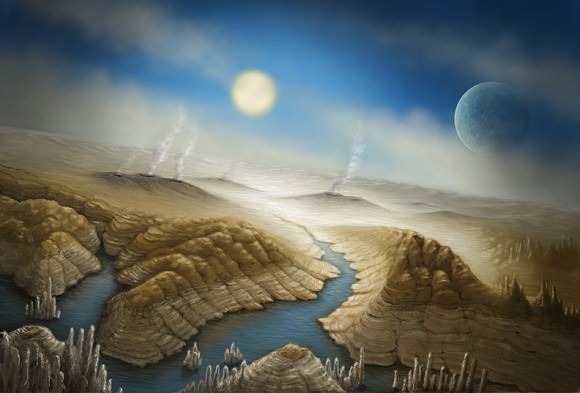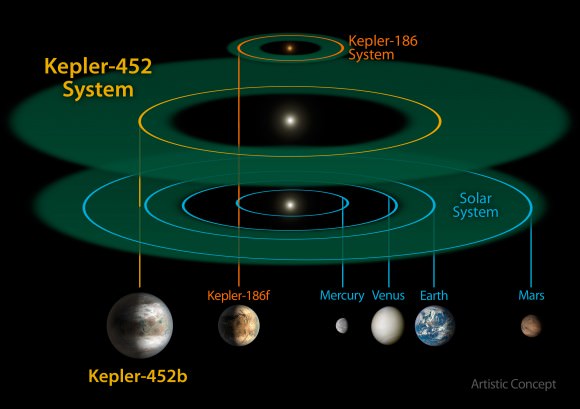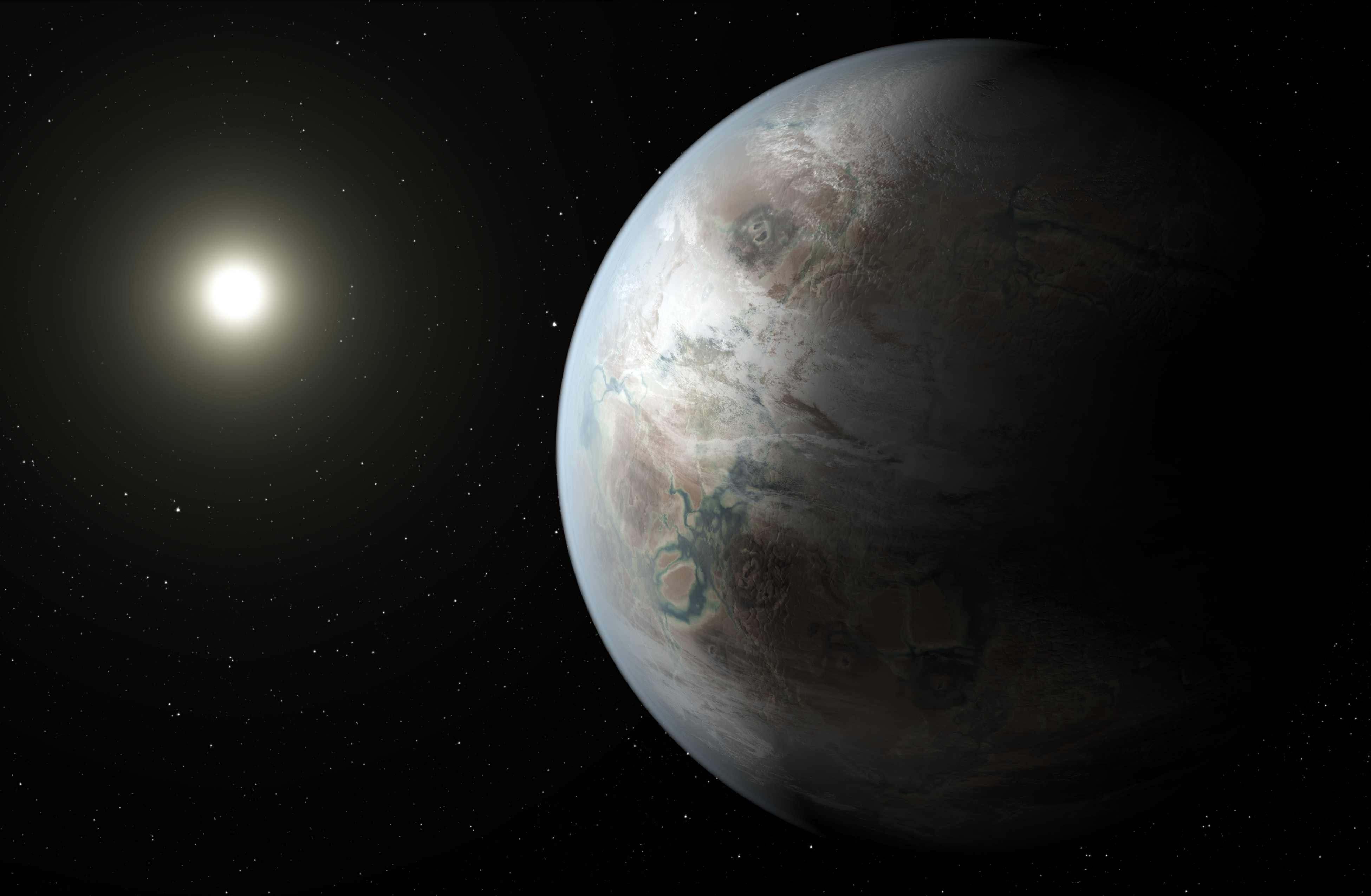Scientists say NASA’s Kepler Space Telescope has discovered Earth’s “older, bigger first cousin” – a planet that’s about 60 percent bigger than our own, circling a sunlike star in an orbit that could sustain liquid water and perhaps life.
“Today, Earth is a little bit less lonely, because there’s a new kid on the block,” Kepler data analysis lead Jon Jenkins, a computer scientist at NASA’s Ames Research Center, said Thursday during a NASA teleconference about the find.
The alien world, known as Kepler-452b, is about 1,400 light-years away in the constellation Cygnus – too far away to reach unless somebody perfects interstellar transporters. But its discovery raises the bar yet again in the search for Earth 2.0, which is a big part of Kepler’s mission.
Jenkins said that Kepler-452b has a better than even chance of being a rocky planet (though there’s some question about that). Its size implies that it’s about five times as massive as Earth. He said the planet might be cloudier than Earth and volcanically active, based on geological modeling. Visiting Earthlings would weigh twice as much as they did on Earth – until they walked around for a few weeks and “lost some serious pounds,” he joked.

The planet is about 5 percent farther from its parent star than Earth is from our sun, with a year that lasts 385 days. Its sun is 10 percent bigger and 20 percent brighter than our sun, with the same classification as a G2 dwarf. But Kepler-452b’s star is older than our 4.6 billion-year-old home star – which suggests the cosmic conditions for life could be long-lasting.
“It’s simply awe-inspiring to consider that this planet has spent 6 billion years in the habitable zone of its star, which is longer than the age of the Earth,” Jenkins said. Models for planetary development suggest that Kepler-452b would experience an increasing warming trend and perhaps a runaway greenhouse effect as it aged, he said.
Kepler-452b’s advantages trump the mission’s earlier planetary discoveries. One involved a rocky planet, just a little bigger than Earth, that was found in its parent star’s habitable zone – that is, the kind of orbit where liquid water could exist. But that star, known as Kepler-186, is a shrunken red dwarf rather than a close analog to the sun.
Kepler research scientist Jeff Coughlin said it’s not clear how hospitable a planet circling a red dwarf might be. A rocky planet in the right orbit around a sunlike star is a surer bet. “We’re here on Earth, we know there’s life here,” he said.
Scientists said Kepler-452b is on the target list for the SETI Institute’s search for radio signals from extraterrestrial civilizations, using the Allen Telescope Array in California – but no alien detection has been reported. “So far, the 452b-ians have been coy,” Seth Shostak, the institute’s senior astronomer and director of the Center for SETI Research, told Universe Today in an email.

John Grunsfeld, NASA’s associate administrator for science, characterized the newly announced planet as the “closest twin” to Earth discovered so far. However, he said further analysis of the Kepler data may turn up even closer relatives.
Launched in 2009, Kepler detects alien worlds by looking for the faint dimming of a star as a planet crosses its disk. The SUV-sized telescope has spotted more than 4,600 planet candidates.
So far, about 1,000 of those have been confirmed as planets using other methods, ranging from detecting their parent stars’ Doppler shifts to carefully measuring the time intervals between the passages of planets. For Kepler-452b, scientists used ground-based observations and computer models to estimate the mass and confirm the detection to a level of 99.76 percent, Jenkins said.
The findings were due to be published online Thursday by the Astrophysical Journal, Jenkins said. In addition to Kepler-452b, another 521 planet candidates have been added to the mission’s checklist – including 12 candidates that appear to be one to two times as wide as Earth and orbit in their parent stars’ habitable zones. Nine of the stars are similar to our own sun in size and temperature, NASA said in a news release.
There’s sure to be more to come. In 2013, Kepler was crippled by failures of its fine-pointing navigation system, but it returned to its planet-hunting mission last year, thanks to some clever tweaking that makes use of the solar wind as an extra stabilizer. “It’s kind of the best-worst thing that ever happened to Kepler,” Jenkins said.


If part of this earth twin’s measurements is a moon, might it even be more like earth?
That dried up parched artists concept of the surface is not too inviting to me, and what are those pillar like things? Ill stay here. YOU can visit that one!
Chris
Getting better. There is a whole lot more planets Earth size or smaller. 1,400 light years! We can stop worrying about travelers from distant stars if this is the best out there. I’m not going to cancel my reservations to Mars yet; even if I could get my deposit back.
When you realize that Kepler can “see” only those planets that pass between us and their sun, and not the myriad others that don’t, well there have to be so many more that it boggles the mind.
Is there life out there? You’re damned right there is!
Intelligent life? Undoubtedly!
Close enough to communicate back and forth with it, in any way, ever? Most likely not. Ever.
Hmmmm i think that they were either too dumb not to have contacted this planet at some stage in last few billion years and leave a note as there sun is 4-6.5 billion years older than our sun give or take a few billion years.So if civilization did progress ,they obviously hit a hurdle to be not around now or to have not destroyed the universe as we know it.
Kinda scary really,
Guess we are the lucky 1st and we will spread through the universe like a parasite to others, or not depends on which countries get out there 1st ,
Let the real race for universe surpremcy begin today,you know in the movies we’re the good guys – Now come on in the real world we know who are going to be the bad asses in this universe.
If there are others things out and about in the universe they are also useless to not have left us anything of interest,sent signals that we can realise,unless they have watched us and thinking we might be abit dodgy to introduce into there world economy and population
but Hmmmm I must admit that it now gives our civilization a target to get to for furture generations,
so this is very exciting,as we will surely start to land on passing asteroids and cruise from asteroid to asteroid and while finding the right trajectories unless other cheap means of travel come along,and there are many options.
Hmmm somthing interesting Russias concentrating on Landing and building bases up on the moon,while america is spending the dollars on our other planets,which is great but for the next 5-15 years russia will dominate the Moon until america realises and starts to concentrate on securing there own areas whereby creating tourists as to in part pay for there expansions.
Those of you who know more than I about the formula for gravity please correct me, but with five times the mass you will have five times the gravity, right? At that level, can any advanced life form exist?
Nope. You forget the planet is also larger: when standing on the surface, you’re farther from the center of mass.
Gravity follows inverse square law for distance; mass is proportional to radius ^3. Supposing the planet is as dense as Earth, its surface gravity is proportional to radius ^3 / radius ^2 = radius!
Cubic root of 5 ~ 1.7, that’s the surface gravity factor relatively to Earth.
BUT its five (5) times the mass, which, if I understand you, would make its surface gravity 8.5 times the surface gravity of Earth. What am I missing?
As I explained, surface gravity ends up directly proportional to radius, for two planets of the same density.
Mass is proportional to radius cubed: 5 times the mass –> 1.7 times the radius –> 1.7 times the gravity.
Where it says the planet is “60% bigger” than earth, does this mean 1.6 times the cross section area, radius, what? Is the “5 times the mass” estimate from other data (orbital parameters) other than the “60% bigger” comment?
Life on any rock with a oxygen/nitrogen atmosphere has a high possibility to exist regardless of gravity. In a higher gravity, it will be a denser form of carbon based life.
Now if the atmosphere is really acidic then all bets are off.
With twice as much weight, would we be able to walk? What would happpen to human body? I guess we would grow some muscles.
But you reach a point where the ability to stand is simply overcome, which will reduce sensory input. Reduce sensory input and you reduce cerebral activity. Reduce cerebral activity and you inhibit brain development. ETC.